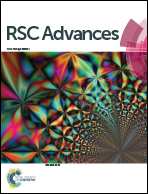Correlation of the average hopping length to the ion conductivity and ion diffusivity obtained from the space charge polarization in solid polymer electrolytes
Abstract
Herein, a physical model, based on impedance spectroscopy and space charge polarization with the consideration of low frequency capacitance dispersion is presented to evaluate the parameters describing the electrical transport properties of some previously studied polymer electrolytes. Implementing the model, the complete frequency response of complex conductivity within the measured frequency range can be imitated, which enables us to appropriately evaluate the macroscopic DC conductivity, hopping frequency and double layer frequency within the measured temperature range. The temperature dependent mobile ion concentration, free-ion diffusivity and average ion hopping length have also been estimated from the analysis of the frequency dependent real and imaginary parts of the complex permittivity spectra, using the same model. Reasonable agreement of the ion diffusivity obtained from the present analysis to that obtained previously from the pulsed-field gradient (PFG) NMR measurements strongly justifies the applicability of the model to a wide variety of ion conducting systems.


 Please wait while we load your content...
Please wait while we load your content...